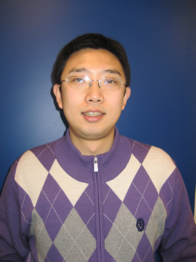High-resolution imprint and soft lithography for patterning self-assembling systems
Promotion date: 26. February 2010
Promotor: Prof. Dr. Ir. Jurriaan Huskens
| Patterning strategies are developed of the combination of bottom-up and top-down techniques to achieve high resolutions of sub-100nm. Several unconventional nanofabrication methods on surfaces are used: soft lithography (microcontact printing, micromolding in capillaries), nanoimprint lithography, capillary force lithography and self-assembled monolayers, particles, bio-molecules, polymers etc. A focus is on high resolutions and high materials versatility, especially combined with specific surface chemistry. The self-assembly behaviour of different systems in a nano-confined situation, has been studied and some applications of these patterned nanostructures have also been discussed. |
What specific approach did you choose in your thesis project?
Using PDMS in nanofabrication has some important advantages. The material is soft, transparent, non-toxic and cheap, to mention a few. Also the contact qualities are special because of the softness of the material. The research has added value for different kind of companies, I believe, as it was part of the NanoNed flagship subsidies system.
The combination of self-assembly and soft lithography, turned out to be very promising, to overcome some fundamental problems reaching sub-100 nanometer regions. Nano-imprint techniques in combination with microcontact printing, resulted in three of the chapters of my thesis report. Three publications are already submitted or under way, including one in Advanced Materials, a highly impact journal.
Did you develop yourself personally, as a researcher or scientist in the thesis period?
In the beginning of the project, I was doubting myself a little. As a polymer chemist, I hardly knew anything about lithography techniques, for example. In the four years of the project, I only performed some minor surface chemistry, otherwise physics, engineering and spending a lot of time in the cleanroom.
Luckily the working atmosphere at Mesa+ is very open. I was able to make use of the expertise of different groups, i.e. the TST group, and the help of the technicians. All colleagues were very friendly, always interested and willing to sit down and talk things through. The very many expertises present, is a big advantage of Mesa+, in my opinion.
Furthermore, I developed myself to do research independently and to bring in my own ideas, especially in the second part of the project.
Do you consider these skills important for your future career?
Yes, very much so. I like to be involved in academic research in the future. I applied for a post-doc job in the United States. In my opinion, I still have to broaden my knowledge in different kind of fields, favourably combining physics, engineering and biology.
I hope the multidisciplinary approach will open opportunities in Chinese research in the future, as I am hoping to start my own research group one day. In China the working atmosphere is not that open yet. Really nice research centres in nanotechnology are already present, for example in Beijing and Shanghai.

